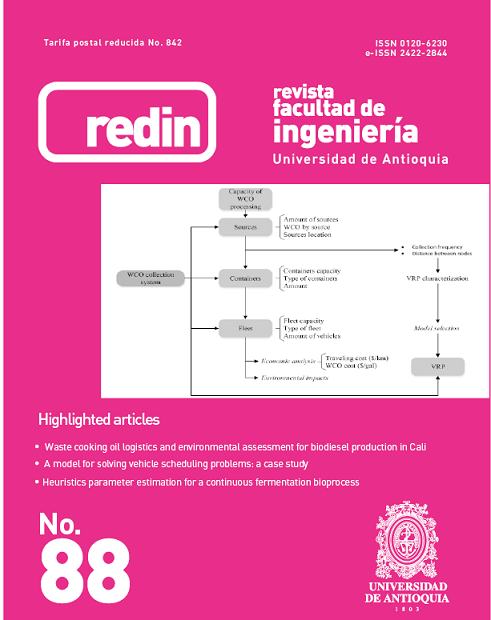Epoxidación de limoneno en fase líquida sobre Ti/KIT-6
DOI:
https://doi.org/10.17533/udea.redin.n88a08Palabras clave:
epoxide de limoneno, Ti soportado en KIT-6, hidroperóxido de terbutiloResumen
Se evaluó la actividad del material Ti/KIT-6 en la epoxidación de limoneno en fase líquida con hidroperóxido de terbutilo como agente oxidante. La mayor selectividad (60%) se obtuvo a 50 ºC después de 7 h de reacción con una conversión de 23%; otros productos detectados fueron carvona, carveol, 1,2-diol-epoxilimoneno, alcohol perílico y p-menta-2,8-dien-1-ol. Se encontró que el catalizador no se lixivia y que antes de reutilizarlo se debe activar a 550 ºC. El catalizador se caracterizó por análisis químico, DRX, UV-vis e isotermas de adsorción.
Descargas
Citas
C. Jo, K. Kim, and R. Ryoo, “Syntheses of high quality KIT-6 and SBA-15 mesoporous silicas using low-cost water glass, through rapid quenching of silicate structure in acidic solution,” Microporous and Mesoporous Materials, vol. 124, no. 1-3, pp. 45–51, Aug 2009.
W. Wang and et al., “Synthesis of KIT-6 type mesoporous silicas with tunable pore sizes, wall thickness and particle sizes via the partitioned cooperative self-assembly process,” Microporous and Mesoporous Materials, vol. 194, pp. 167–173, Aug 2014.
A. Seidel, M. Bickford, S. Thomas, and K. Chu, Kirk-Othmer Chemical Technology of Cosmetics, 1st ed. Hoboken, NJ: John Wiley & Sons, 2013.
C. M. Byrne, S. D. Allen, E. B. Lobkovsky, and G. W. Coates, “Alternating copolymerization of limonene oxide and carbon dioxide,” Journal of American Chemical Society, vol. 126, no. 37, pp. 11 404–11 405, Aug 2004.
M. V. Cagnoli and et al., “Clean limonene epoxidation using Ti-MCM-41 catalyst,” Applied Catalysis A: General, vol. 287, no. 2, pp. 227–235, Jun 2005.
M. Guidotti, N. Ravasio, R. Psaro, G. Ferraris, and G. Moretti, “Epoxidation on titanium-containing silicates: do structural features really affect the catalytic performance?” Journal of Catalysis, vol. 214, no. 2, pp. 242–250, Mar 2003.
M. Guidotti, R. Psaro, I. Batonneau, and E. Gavrilova, “Heterogeneous catalytic epoxidation: High limonene oxide yields by surface silylation of Ti-MCM-41,” Journal of Catalysis, vol. 34, no. 11, pp. 1924–1927, Nov 2011.
M. V. Cagnoli and et al., “Ti-MCM-41 silylation: Development of a simple methodology for its estimation silylation effect on the activity and selectivity in the limonene oxidation with h2o2,” Catalysis Today, vol. 107-108, pp. 397–403, Oct 2005.
A. Wróblewska, “The epoxidation of limonene over the TS-1 and Ti-SBA-15 catalysts,” Molecules, vol. 19, no. 12, pp. 19 907–19 922, Nov 2014.
D. Marino and et al., “Ti-MCM-41 catalysts prepared by post-synthesis methods limonene epoxidation with h2o2,” Catalysis Today, vol. 133-135, pp. 632–638, Apr 2008.
A. Wróblewska, E. Makuch, and P. Miadlicki, “The studies on the limonene oxidation over the microporous TS-1 catalyst,” Catalysis Today, vol. 268, pp. 121–129, Jun 2016.
A. J. Bonon and et al., “Limonene epoxidation with h2o2 promoted by al2o3: Kinetic study, experimental design,” Journal of Catalysis, vol. 319, pp. 71–86, Nov 2014.
A. Vinu and et al., “Three-dimensional mesoporous TiKIT-6 with ia3d symmetry synthesized at low acid concentration and its catalytic performances,” Chemistry Letters, vol. 37, no. 10, pp. 1016–1017, Sep 2008.
L. Kumaresan, A. Prabhu, M. Palanichamy, and V. Murugesan, “Mesoporous Ti-KIT-6 molecular sieves: Their catalytic activity inthe epoxidation of cyclohexene,” Journal of the Taiwan Institute of Chemical Engineers, vol. 41, no. 6, pp. 670–675, Nov 2010.
F. Kleitz, L. A. Solovyov, G. M. Anilkumar, S. H. Choi, and R. Ryoo, “Transformation of highly ordered large pore silica mesophases (Fm3m, Im3m and p6mm) in a ternary triblock copolymer-butanol-water system,” Chemical communications, no. 13, pp. 1536–1537, 2004.
C. Berlini, M. Guidotti, G. Moretti, R. Psaro, and N. Ravasio, “Catalytic epoxidation of unsaturated alcohols on Ti-MCM-41,” Catalysis Today, vol. 60, no. 3-4, pp. 219–225, Jul 2000.
V. Hulea and E. Dumitriu, “Styrene oxidation with h2o2 over ti-containing molecular sieves with MFI, BEA and MCM-41 topologies,” Applied Catalysis A: General, vol. 277, no. 1-2, pp. 99–106, Dec 2004.
C. Reichardt and T. Welton, Solvents and Solvent Effects in Organic Chemistry, 4th ed. Weinheim, Germany: WILEY-VCH Verlag GmbH & Co, 2011.
Descargas
Publicado
Cómo citar
Número
Sección
Licencia
Derechos de autor 2018 Revista Facultad de Ingeniería Universidad de Antioquia

Esta obra está bajo una licencia internacional Creative Commons Atribución-NoComercial-CompartirIgual 4.0.
Los artículos disponibles en la Revista Facultad de Ingeniería, Universidad de Antioquia están bajo la licencia Creative Commons Attribution BY-NC-SA 4.0.
Eres libre de:
Compartir — copiar y redistribuir el material en cualquier medio o formato
Adaptar : remezclar, transformar y construir sobre el material.
Bajo los siguientes términos:
Reconocimiento : debe otorgar el crédito correspondiente , proporcionar un enlace a la licencia e indicar si se realizaron cambios . Puede hacerlo de cualquier manera razonable, pero no de ninguna manera que sugiera que el licenciante lo respalda a usted o su uso.
No comercial : no puede utilizar el material con fines comerciales .
Compartir igual : si remezcla, transforma o construye a partir del material, debe distribuir sus contribuciones bajo la misma licencia que el original.
El material publicado por la revista puede ser distribuido, copiado y exhibido por terceros si se dan los respectivos créditos a la revista, sin ningún costo. No se puede obtener ningún beneficio comercial y las obras derivadas tienen que estar bajo los mismos términos de licencia que el trabajo original.










 Twitter
Twitter